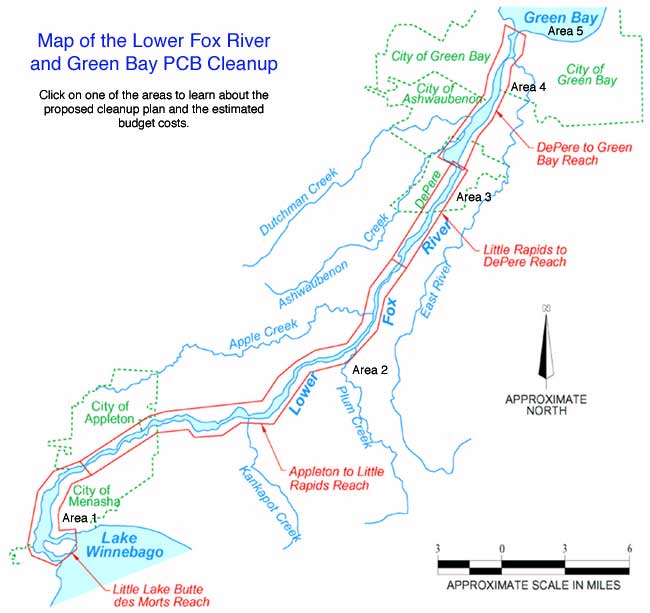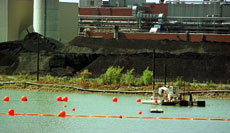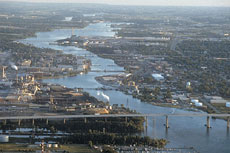Dredging Through the Cleanup
By Jessica
Schim
 |
For information about the Fox River areas click on the map. |
Three decades after Wisconsin paper mills dumped pollutants
into the Fox River, these contaminants continue to threaten the health
of fish, wildlife and even humans. Now the state and federal governments
are mandating a cleanup of the Fox River and Green Bay. With a $400
million project looming, the debate over responsibility for the cleanup
is as muddy as the riverbed itself, but the funding flows forward.
According to the U.S. Environmental Protection Agency
(EPA), sufficient evidence suggests that polychlorinated biphenyls
(PCBs) may cause cancer in animals. Commercial use of PCBs, the key
ingredient used to recycle carbonless paper, was banned in 1979 for
health concerns. Seven Wisconsin mills have been identified as potentially
responsible for contaminating the Fox River with PCBs before that
time. The companies include: Appleton (formerly Appleton Papers Inc.),
its former owners Arjo Wiggins and NCR Corp., Georgia-Pacific Corp.,
P.H. Glatfelter Co., Riverside Paper Corp., Sonoco and Chesapeake
Corp.
The estimated $400 million cost of the cleanup is the largest in
Wisconsin history and one of the largest in EPA history. Dividing
this cost fairly between the mills will depend on how much of the
65,000 pounds of contaminants the individual mills originally dumped
into the river and bay. How, exactly, this would be determined remains
murky.
“Any record or evidence to prove share either doesn’t
exist or is difficult to find or verify with the standard of proof
that
is required in cases like this,” says Chris Gower, general
counsel for Arjo Wiggins Appleton. “It is not an easy thing
to do.”
Mill location may play a role in determining which companies are
responsible for cleaning up particular areas. The river and the bay
are divided into five contaminated areas, each with its own cleanup
plans and expenses:
Managing the Cleanup
This year’s releases of the Records of Decision, which are
detailed documents explaining the current state of the river and
potential cleanup options, are a major step toward cleaning the river.
But the DNR’s proposal to dredge all of the areas except Green
Bay has split views on what is best for the river. The DNR calls
dredging the most reasonable and economic option. However, several
of the companies involved, as well as the Wisconsin Paper Council
(a trade association representing the pulp, paper and allied industries),
argue that capping certain contaminated areas with sand and gravel
is a better alternative.
|
|
CourtesyArjo WigginsAppleton
|
An overview of part of the lower Fox
River
that needs dredging. |
“It is hard to say [if capping will happen],
but I would certainly hope that for parts of the river that are outside
of the main channel … that it will become a viable option,” says
Pat Schillinger, president of the Wisconsin Paper Council.
Paying the price for a clean environment
In addition to deciding who will pay what for the cleanup, nobody
is sure who should actually tackle the task. But while these debates
continue, the mills have started to take action, hoping to create
noticeable ripples. The companies have continued to make contributions
to both individual and joint cleanup efforts, and neither the DNR
nor the EPA has taken any enforcement action yet.
For example, Georgia-Pacific contributed more than $35 million to
the cleanup and this year gave $4 million for funding that the state
sought for additional river monitoring.
“Our position all along has been that we recognize
that we are part of the problem and need to be part of the solution,” says
Al Toma, regional manager for governmental affairs for Georgia-Pacific. “That
solution needs to be responsive environmentally and at the same
time that solution needs to be economically viable, but I do think
that
it is a fair statement that we have taken a leadership role in
trying to continue and see that this project is going forward.”
Other companies have made similar contributions, but this proves
more difficult when new parent companies have since taken over. Arjo
Wiggins Appleton is in this position as the former parent company
of Appleton Papers Inc. It sold Appleton Papers to its employees
in November 2001.
As a result, an agreement between Arjo Wiggins and Appleton binds
Arjo Wiggins to pay for the first $75 million, with Appleton paying
for the next $25 million. Arjo Wiggins will be responsible for any
additional costs.
 |
| Courtesy of Green Bay Press Gazette |
| The cleanup of the Fox River promises
to be an extremely expensive process. |
Two other companies, P.H. Glatfelter Co. and WTM 1, signed an agreement
to each pay $25 million for cleanup of the Little Lake Butte
des Morts area. The companies will also each pay $3 million for natural
resource damage to the river.
This includes the expenses associated
with the loss of fishing opportunities as the result of PCB pollution.
While the companies try to improve the health of the river and bay
they once threatened, their large contributions may hurt the
mills’ finances
and the overall state of the Fox River paper industry.
"It is safe to say … that the issue of the Fox River cleanup
has been a contributing factor to the decline of the paper industry
in the Fox River Valley,” Gower says. “If nothing
else, the issue has acted as a fetter on further investment in
the Valley.”
The future of the project
During the next several months, the contributions will stream forth
steadily, and the debates will continue as certain areas go forward
with some initial cleanup efforts. Yet the costs and benefits of
the plan may remain muddy for decades, leaving the future of the
Fox River as cloudy as the river itself.
To learn more about the Fox River contamination cleanup initiatives
visit these sites:
Department
of Natural Resources: Visit this Web site for further information
about initiatives to cleanup the Fox River.
National Cash
Register:
Visit
this Web site to learn more about NCR and their role in PCB contamination.
Georgia
Pacific: Visit this Web site to
learn more about Georgia Pacific and their role in PCB contamination.
Fox River
Facts:
Visit this Web site to learn more in-depth infomation about the
Fox River and it's future.









